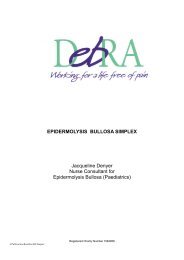Annual Review 2012 - DebRA
Annual Review 2012 - DebRA
Annual Review 2012 - DebRA
- No tags were found...
You also want an ePaper? Increase the reach of your titles
YUMPU automatically turns print PDFs into web optimized ePapers that Google loves.
DEBRA UK is seeking funding for thefollowing projects:£450,000 Aim: Phase I/II Clinical trial ofmesenchymal stromal cells in RDEB. Prof JohnMcGrath, Great Ormond Street Hospital forChildren NHS Trust (London) and UniversityCollege London. 3 year project.Bone-marrow derived MSC are multipotent stemcells that can differentiate into cell types in a widevariety of tissue, including skin. MSC are suitedto tissue-engineering and, when transplanted inthe bloodstream, they travel to the site of injury.Findings to date suggest that injections of MSCto treat EB report some benefits and limited sideeffects. This project will perform a phase I/IIclinical trial of intravenously administered bonemarrow-derived mesenchymal stromal cells(MSCs) in 10-20 children with recessivedystrophic epidermolysis bullosa (RDEB).£97,500 Aim: To document a natural history ofEB and validate Clinical Endpoints appropriate toTherapy Evaluation by industry and regulatoryauthorities. Dr Jemma Mellerio and Dr AnnaMartinez, Great Ormond Street Hospital andGuys & St Thomas. First 2 years of planned 5year programme.With many DEBRA funded research avenues nowleading to clinical trials it is imperative thatDEBRA is in the right position to developpartnerships to move the science into patientaccessible treatments. In order to do this, weneed to facilitate regulatory approval of potentialtherapies, and be able to attract industry andventure capital to invest in getting treatments intoproduction and be able to persuade healthcarefunders to pay for the therapy.DEBRA’s Translational Research Advisory Panel(TRAP) has advised that it is important forcompanies thinking of investing in clinical trialsto know there is a clear understanding of whatthe ‘normal’ course of the condition is.Additionally we must be able to show thattreatment under trial has been effective in such away as to ensure it will be accepted by theregulators who determine whether a treatment issafe and effective enough to be approved.€260,000 Aim: To develop therapies whichcombine ex vivo gene therapy with stem celltransplantation for Junctional EB. Prof. JohannBauer (Salzburg), Prof. Michele De Luca (Italy),Prof Christopher Baum (Germany). 3 year project.This project builds upon the success of the firstex vivo skin gene therapy trial in Italy. This PhaseI/IIa clinical trial will take stem cells from an EBpatient for the production of genetically modifiedskin grafts for use on the same patient. Thesegrafts can be repeated until large parts of thedamaged layers of the skin are covered with“new” skin. In this way several of the clinicalhallmarks of EB are combated:• No more loss of body fluids thus reduction inloss of proteins and peptides• Improved barrier defence against microbialinfection• Lessening likelihood of cancer developing dueto long-standing wound areas$250,000 Aim: To develop TALEN gene-correctiontechnology re individualised stem-cell therapyoptions for children with RDEB, Dr Jakub Tolar,University of Minnesota, I year project (selectedfor funding through the Sohana Research Fund)The ultimate goal is to develop safer, moreeffective, personalised treatment options for thechildren with EB, especially those undergoingthe systemic therapy of EB commonly calledBone Marrow Transplantation (BMT). In order toavoid serious transplant associated side effects,the ideal treatment would collect the patientsown cells, correct the gene defect, and deliverthe corrected cells back to the patient.This project proposes to unify two cutting edgetechnologies, involving the generation ofinducible pluripotent stem cells (iPS) – cellscapable of differentiating into any other cell type– and the powerful gene-editing, site directed,“molecular scissors” platform known as TALENsto realise the potential of individualised,genomic-medicine-based cellular therapy for EB.By the conclusion of the project, the aim is tohave provided proof of principle for the feasibilityof a truly individualised (therefore safer andmore effective), genomics-based medicineapproach for the treatment of EB.5




